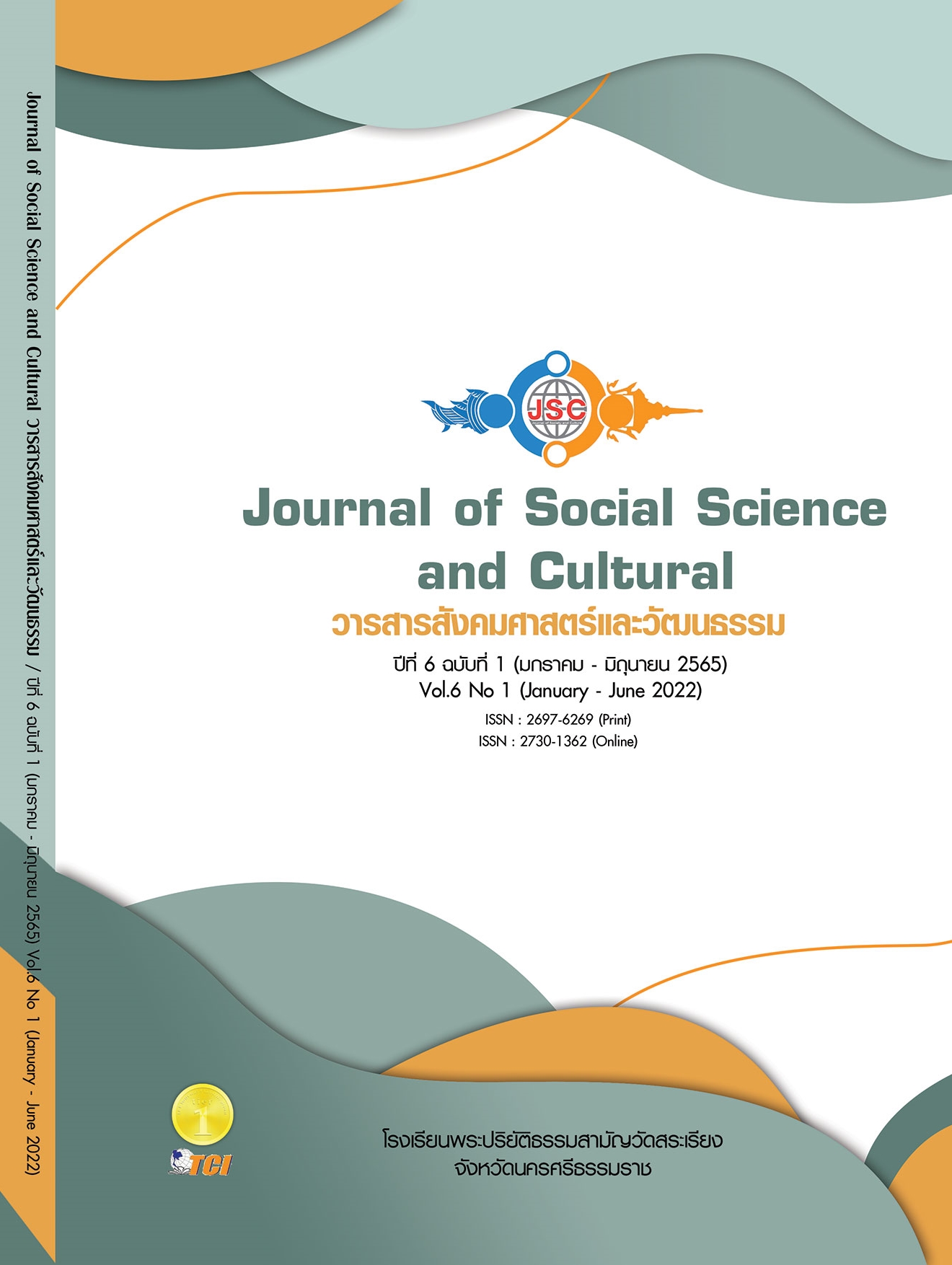แผนที่ทางเดินยุทธศาสตร์กับการพัฒนาชุมชน: การเรียนรู้เพื่อเสริมพลังอำนาจความรอบรู้ทางสุขภาพจากชุมชนฐานราก
Main Article Content
บทคัดย่อ
บทความวิจัยฉบับนี้มีวัตถุประสงค์เพื่อ 1) นำเสนอแนวคิดและความสำคัญของแผนที่ทางเดินยุทธศาสตร์ 2) ประเมินความต้องการการสร้างเสริมสุขภาวะและคุณภาพชีวิตในการพัฒนาชุมชน และ 3) พัฒนาข้อเสนอแนวทางการบูรณาการการใช้แผนที่ทางเดินยุทธศาสตร์ในการขับเคลื่อนการพัฒนาชุมชน เป็นวิจัยเชิงคุณภาพศึกษาข้อมูลจากเอกสาร ใช้แบบสัมภาษณ์เชิงลึก สนทนากลุ่ม และสังเกตการณ์อย่างมีส่วนร่วม ผู้ให้ข้อมูลสำคัญ ได้แก่ ผู้ประสานงานโครงการ อาสาสมัครสาธารณสุขประจำหมู่บ้าน แกนนำชุมชนต้นแบบที่มีบทบาทเกี่ยวข้องกับการทำงานสร้างเสริมสุขภาพและคุณภาพชีวิตของชุมชน เป็นการคัดเลือกแบบเจาะจงจากตัวแทน 4 กลุ่ม ได้แก่ 1) กลุ่มตัวแทนภาคประชาชน 2) กลุ่มตัวแทนโครงการสร้างเสริมสุขภาพ 3) กลุ่มตัวแทนองค์กรปกครองส่วนท้องถิ่น และ 4) กลุ่มตัวแทนเจ้าหน้าที่ภาครัฐ กลุ่มละ 10 คน จำนวนทั้งหมด 40 คน โดยวิเคราะห์ข้อมูลเชิงเนื้อหา และสรุปบทเรียน ผลการศึกษาพบว่า 1) แผนที่ทางเดินยุทธศาสตร์เป็นเครื่องมือการบริหารการเปลี่ยนแปลงและเสริมพลังการขับเคลื่อนงาน สามารถวางแผนการดำเนินการ มีการติดตามผลทั้งระหว่างการดำเนินการและประเมินผลหลังการดำเนินการ และบริหารจัดการโครงการหรือกิจกรรมให้สู่เป้าหมายได้ 2) ประเมินความต้องการการสร้างเสริมสุขภาวะและคุณภาพชีวิตในการพัฒนาชุมชนพบว่ามีเป้าหมายร่วม 3 ประการ ได้แก่ สิ่งแวดล้อมที่ดี ความปลอดภัยในการดำเนินชีวิต และความสามัคคีของชุมชน และ 3) แนวทางการใช้แผนที่ทางเดินยุทธศาสตร์เป็นเครื่องมือสำหรับกระบวนการเรียนรู้และเสริมพลังชุมชน จะต้องมีองค์ประกอบพื้นฐาน 6 ประการ ได้แก่ ผู้นำกิจกรรมต้องมีทักษะกระบวนกร ประชาชนเป็นศูนย์กลาง เปิดกว้างสู่การเรียนรู้ การเสริมสร้างการมีส่วนร่วม ความสอดคล้องกับความจำเป็นของชุมชน และความต้องเป็นการสื่อสารเชิงบวก
Article Details
เอกสารอ้างอิง
ชาย โพธิสิตา. (2550). ศาสตร์และศิลป์แห่งการวิจัยเชิงคุณภาพ. (พิมพ์ครั้งที่ 3). กรุงเทพมหานคร: อมรินทร์พริ้นติ้งฯ.
นิตยา เพ็ญศิรินภา. (2554). แผนที่ทางเดินยุทธศาสตร์กับการพัฒนางานด้านสร้างเสริมสุขภาพและป้องกันโรคของโรงพยาบาลส่งเสริมสุขภาพตำบล. เรียกใช้เมื่อ 6 เมษายน 2565 จาก https://www.stou.ac.th/Schools/Shs/booklet/book541/pbhealth.html
เบ็ญจา ยมสาร. (2557). การพัฒนาแผนที่ทางเดินยุทธศาสตร์การสร้างเสริมสุขภาวะเยาวชน จังหวัดนครสวรรค์. วารสารการพยาบาล การสาธารณสุขและสุขศึกษา, 15(3), 55-68.
มูลนิธิแสงสุทธิการ(เพื่อพัฒนาคุณภาพชีวิต). (2552). โครงการส่งเสริมและพัฒนาศักยภาพการใช้แผนที่ทางเดินยุทธศาสตร์ (Strategic Route Map) ในการพัฒนางานสร้างเสริมสุขภาพและป้องกันโรคในระดับจังหวัด (รายงานผลการดำเนินงาน). กรุงเทพมหานคร: มูลนิธิแสงสุทธิการ (เพื่อพัฒนาคุณภาพชีวิต).
วัชราพร เชยสุวรรณ. (2560). ความรอบรู้ด้านสุขภาพ : แนวคิดและการประยุกต์สู่การปฏิบัติการพยาบาล. วารสารแพทย์นาวี, 44(3), 183-197.
ศิริพร จิรวัฒน์กุล. (2552). การวิจัยเชิงคุณภาพด้านวิทยาศาสตร์สุขภาพ. กรุงเทพมหานคร: วิทยพัฒน์.
สถาบันวิจัยประชากรและสังคม. (2564). สุขภาพคนไทย 2564 : COVID-19 มหันตภัยร้ายเขย่าโลก. นครปฐม: สถาบันวิจัยประชากรและสังคม มหาวิทยาลัยมหิดล.
สำนักงานปลัดกระทรวงสาธารณสุข. (2561). แผนยุทธศาสตร์ชาติ ระยะ 20 ปี ด้านสาธารณสุข (พ.ศ.2560 - 2579) ฉบับปรับปรุง ครั้งที่ 2 (พ.ศ. 2561). นนทบุรี: กองยุทธศาสตร์และแผนงาน สำนักงานปลัดกระทรวงสาธารณสุข.
อมร นนทสุต. (2559). วิวัฒนาการของแผนที่ทางเดินยุทธศาสตร์ การจัดค่ากลาง การบูรณาการ การสร้างนวัตกรรม. กรุงเทพมหานคร: มูลนิธิแสงสิทธิการ (เพื่อคุณภาพชีวิต.
อำนาจ ศรีรัตนบัลล์. (2560). การสร้างเสริมสุขภาพและการเสริมพลังชุมชน. กรุงเทพมหานคร: สำนักสร้างสรรค์โอกาสและนวัตกรรม (สำนัก 6) สำนักงานกองทุนสนับสนุนการสร้างเสริมสุขภาพ.


